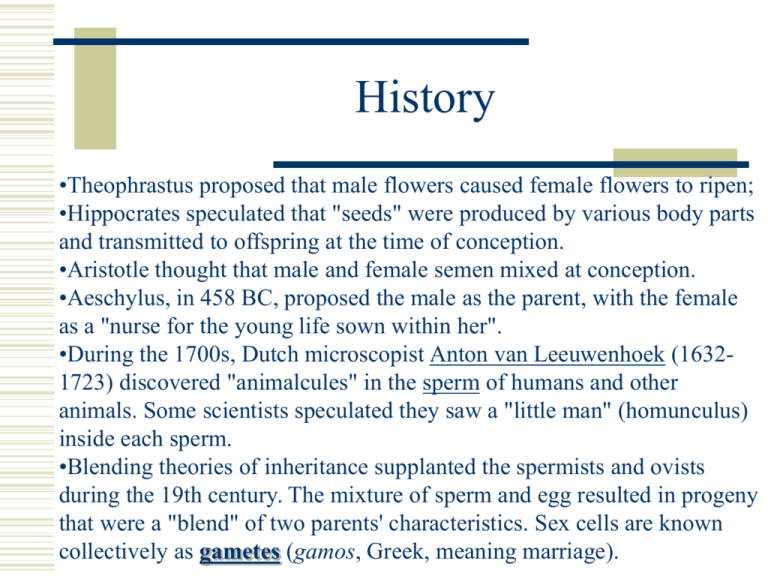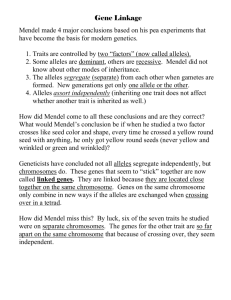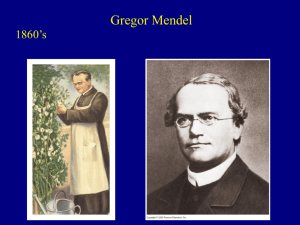statgen2
advertisement

History •Theophrastus proposed that male flowers caused female flowers to ripen; •Hippocrates speculated that "seeds" were produced by various body parts and transmitted to offspring at the time of conception. •Aristotle thought that male and female semen mixed at conception. •Aeschylus, in 458 BC, proposed the male as the parent, with the female as a "nurse for the young life sown within her". •During the 1700s, Dutch microscopist Anton van Leeuwenhoek (16321723) discovered "animalcules" in the sperm of humans and other animals. Some scientists speculated they saw a "little man" (homunculus) inside each sperm. •Blending theories of inheritance supplanted the spermists and ovists during the 19th century. The mixture of sperm and egg resulted in progeny that were a "blend" of two parents' characteristics. Sex cells are known collectively as gametes (gamos, Greek, meaning marriage). Mendel An Austrian monk, Gregor Mendel, developed the fundamental principles that would become the modern science of genetics. Mendel demonstrated that heritable properties are parceled out in discrete units, independently inherited. These eventually were termed genes . Mendel’s experiments Mendel reasoned an organism for genetic experiments should have: 1. a number of different traits that can be studied 2. plant should be self-fertilizing and have a flower structure that limits accidental contact 3. offspring of self-fertilized plants should be fully fertile. Mendel's experimental organism was a common garden pea (Pisum sativum,)). Peas Monohybrids Mendel studied the inheritance of seed shape first. A cross involving only one trait is referred to as a monohybrid cross. Mendel crossed pure-breeding (also referred to as true-breeding) smooth-seeded plants with a variety that had always produced wrinkled seeds (60 fertilizations on 15 plants). All resulting seeds were smooth. The following year, Mendel planted these seeds and allowed them to self-fertilize. He recovered 7324 seeds: 5474 smooth and 1850 wrinkled. Genetic generations Parental generation is denoted as the P1 generation. The offspring of the P1 generation are the F1 generation (first filial). The self-fertilizing F1 generation produced the F2 generation (second filial). P1: smooth X wrinkled F1 : all smooth F2 : 5474 smooth and 1850 wrinkled Mechanism Meiosis Dominant Vs recessive traits When "true-breeding" tall plants were crossed with "true-breeding" short plants, all of the offspring were tall plants. The trait referred to as tall was considered dominant, while short was recessive. Dominant traits were defined by Mendel as those which appeared in the F1 generation in crosses between true-breeding strains. Recessives were those which "skipped" a generation, being expressed only when the dominant trait is absent. Mendel's plants exhibited complete dominance Conclusions 1. Evidence indicated factors could be hidden or unexpressed, these are the recessive traits. 2. The term phenotype refers to the outward appearance of a trait, while the term genotype is used for the genetic makeup of an organism. 3. Male and female contributed equally to the offsprings' genetic makeup: therefore the number of traits was probably two (the simplest solution). 4. Upper case letters are traditionally used to denote dominant traits, lower case letters for recessives. Genetic Terms Gene - a unit of inheritance that usually is directly responsible for one trait or character. Allele - an alternate form of a gene. Usually there are two alleles for every gene, sometimes as many a three or four. Homozygous - when the two alleles are the same. Heterozygous - when the two alleles are different, in such cases the dominant allele is expressed. Dihybrid Crosses Mendel also considered two traits per cross (dihybrid, as opposed to single-trait-crosses, monohybrid), The resulting (F2) generation did not have 3:1 dominant:recessive phenotype ratios. The two traits, if considered to inherit independently, fit into the principle of segregation. Instead of 4 possible genotypes from a monohybrid cross, dihybrid crosses have as many as 16 possible genotypes. Crosses With Two Traits Smooth seeds (S) are dominant over wrinkled (s) seeds, seed color (Y) is dominant over green (g). Mendel started with true-breeding plants that had smooth, yellow seeds and crossed them with truebreeding plants having green, wrinkled seeds. All seeds in the F1 had smooth yellow seeds. The F2 had four phenotypes: 315 smooth yellow 108 smooth green 101 wrinkled yellow 32 wrinkled green Dihybrid Results The Punnett Square has 16 boxes. Since there are more possible combinations to produce a smooth yellow phenotype (SSYY, SsYy, SsYY, and SSYy), that phenotype is more common in the F2. Principle of Independent Assortment When gametes are formed, alleles assort independently. If traits assort independent of each other during gamete formation, the results of the dihybrid cross can make sense. We now interpret the Principle of Independent Assortment as alleles of genes on different chromosomes are inherited independently during the formation of gametes. Genetic Terms Gene - a unit of inheritance that usually is directly responsible for one trait or character. Allele - an alternate form of a gene. Usually there are two alleles for every gene, sometimes as many a three or four. Homozygous - when the two alleles are the same. Heterozygous - when the two alleles are different, in such cases the dominant allele is expressed. Genetic Terms Dominant - a term applied to the trait (allele) that is expressed irregardless of the second allele. Recessive - a term applied to a trait that is only expressed when the second allele is the same (e.g. short plants are homozygous for the recessive allele). Phenotype - the physical expression of the allelic composition for the trait under study. Genotype - the allelic composition of an organism. Punnett squares - probability diagram illustrating the possible offspring of a mating. DNA Friedrich Meischer in 1869 isolated DNA from fish sperm and the pus of open wounds. Since it came from nuclei, Meischer named this new chemical, nuclein. Subsequently the name was changed to nucleic acid and lastly to deoxyribonucleic acid (DNA). Robert Feulgen, in 1914, discovered that fuchsin dye stained DNA. DNA was then found in the nucleus of all eukaryotic cells. DNA structure During the 1920s, biochemist P.A. Levene analyzed the components of the DNA molecule. He found it contained four nitrogenous bases: cytosine, thymine, adenine, and guanine; deoxyribose sugar; and a phosphate group. The nucleotide, is the fundemantal unit (monomer) of the nucleic acid polymer. There are four nucleotides: those with cytosine (C), those with guanine (G), those with adenine (A), and those with thymine (T). DNA Structure DNA structure DNA is a double helix, with bases to the center (like rungs on a ladder) and sugarphosphate units along the sides of the helix (like the sides of a twisted ladder). DNA Bonds Notice that a double-ringed purine is always bonded to a single ring pyrimidine. Purines are adenine (A) and guanine (G). Pyrimidines are cytosine (C) and Thymine (T). The bases are complementary, with A on one side of the molecule you only get T on the other side, similarly with G and C. DNA Replication Semiconservative replication.Each DNA molecule is composed of onehalf of the parental DNA along with an entirely new complementary strand. In other words the new DNA consists of one new and one old strand of DNA. The existing strands serve as complementary templates for the new strand. DNA Replication . DNA polymerases unzip the helix by breaking the H-bonds between bases. Once the polymerases have opened the molecule, an area known as the replication bubble forms (always initiated at a certain set of nucleotides, the origin of replication). New nucleotides are placed in the fork and link to the corresponding parental nucleotide already there (A with T, C with G). Since the DNA strands are antiparallel, and replication proceeds in thje 5' to 3' direction on EACH strand, one strand will form a continuous copy, while the other will form a series of short Okazaki fragments. Genetic Code Human genetics There are 44 autosomes and 2 sex chromosomes: X and Y in the human genome, for a total of 46. Any combination containing Y (up to XXXXY) will create a male. In order to create a reproductive female, one requires 2 X chromosomes. Summary Human genetic information is a random selection of parental DNA Each chromosome selection is independent. In the translation from genoype to phenotype some of the information is hidden. We will now learn how to infer the genotype from the phenotype and study the dynamics of the genetic material Example of Pedigree A1/A1 Male A2/A2 Female A1/A2 A1/A2 A2/A2 A2/A2 A1/A2 A2/A2 Two alleles model Let us assume a gene containing two mutually exclusive alleles:A1,A2. There are three possible combinations:A1/A1,A1/A2 and A2/A2, with initial frequencies: u,v and w. u+v+w=1 Let us compute thir density after one division








